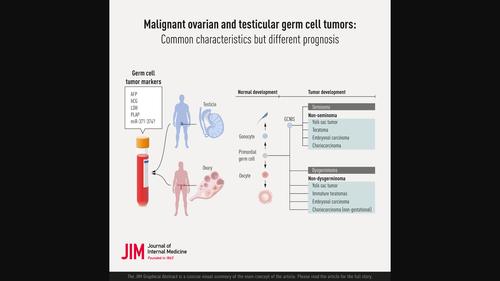当前位置:
X-MOL 学术
›
J. Intern. Med.
›
论文详情
Our official English website, www.x-mol.net, welcomes your feedback! (Note: you will need to create a separate account there.)
Malignant ovarian and testicular germ cell tumors: Common characteristics but different prognoses
Journal of Internal Medicine ( IF 11.1 ) Pub Date : 2024-03-12 , DOI: 10.1111/joim.13778 Camilla Sköld 1 , Anna K Jansson 1 , Ingrid Glimelius 1, 2
Journal of Internal Medicine ( IF 11.1 ) Pub Date : 2024-03-12 , DOI: 10.1111/joim.13778 Camilla Sköld 1 , Anna K Jansson 1 , Ingrid Glimelius 1, 2
Affiliation

|
Both ovarian and testicular germ cell tumors (GCTs) arise from the primordial germ cell and share many similarities. Both malignancies affect mainly young patients, show remarkable responsiveness to cisplatin‐based therapy, and have an excellent prognosis, which also highlights the importance of minimizing long‐term side effects. However, certain differences can be noted: The spreading of the disease differs, and the staging system and treatment recommendations are dissimilar. Moreover, the prognosis for ovarian GCTs is significantly inferior to that for testicular cancer, as exemplified in this review comparing the survival in Swedish patients diagnosed with testicular (1995–2022) and ovarian (1990–2018) GCTs. The 5‐year overall survival in ovarian GCTs was 85.2%, versus 98.2% for testicular GCTs. How can this be explained? One reason may be the difference in knowledge, experience, and evidence because the incidence rate of testicular cancer is more than 15 times that of ovarian GCTs. Given the rarity of the disease in women and the lack of established guidelines, a comprehensive understanding of the disease and treatment decisions is challenging. The main objective of this review is to derive insights from testicular GCTs (seminoma and non‐seminoma) by reviewing etiological, tumor biological, and clinical knowledge, and to thereafter suggest actions for ovarian GCTs based on this. We hypothesize that by adopting specific treatment strategies from testicular GCTs—including de‐escalating adjuvant chemotherapy for low‐risk patients and implementing more standardized and intensive treatment protocols in cases of relapse—we can improve the prognosis and minimize long‐term side effects in ovarian GCT patients.
中文翻译:

恶性卵巢和睾丸生殖细胞肿瘤:共同特征但不同的预后
卵巢和睾丸生殖细胞肿瘤(GCT)均起源于原始生殖细胞,并且有许多相似之处。这两种恶性肿瘤主要影响年轻患者,对基于顺铂的治疗表现出显着的反应,并且预后良好,这也凸显了尽量减少长期副作用的重要性。然而,可以注意到某些差异:疾病的传播不同,分期系统和治疗建议也不同。此外,卵巢GCT的预后明显低于睾丸癌,正如本综述比较了瑞典诊断为睾丸癌(1995-2022年)和卵巢癌(1990-2018年)GCT的患者的生存率所举例说明的那样。卵巢 GCT 的 5 年总生存率为 85.2%,而睾丸 GCT 的 5 年总生存率为 98.2%。这该如何解释呢?原因之一可能是知识、经验和证据的差异,因为睾丸癌的发病率是卵巢癌的15倍以上。鉴于该疾病在女性中罕见且缺乏既定指南,全面了解该疾病和治疗决策具有挑战性。本综述的主要目的是通过回顾病因学、肿瘤生物学和临床知识,从睾丸 GCT(精原细胞瘤和非精原细胞瘤)中获得见解,并据此提出卵巢 GCT 的行动建议。我们假设,通过采用睾丸 GCT 的特定治疗策略(包括对低风险患者逐步降低辅助化疗以及在复发病例中实施更标准化和强化的治疗方案),我们可以改善预后并最大限度地减少卵巢的长期副作用GCT患者。
更新日期:2024-03-12
中文翻译:

恶性卵巢和睾丸生殖细胞肿瘤:共同特征但不同的预后
卵巢和睾丸生殖细胞肿瘤(GCT)均起源于原始生殖细胞,并且有许多相似之处。这两种恶性肿瘤主要影响年轻患者,对基于顺铂的治疗表现出显着的反应,并且预后良好,这也凸显了尽量减少长期副作用的重要性。然而,可以注意到某些差异:疾病的传播不同,分期系统和治疗建议也不同。此外,卵巢GCT的预后明显低于睾丸癌,正如本综述比较了瑞典诊断为睾丸癌(1995-2022年)和卵巢癌(1990-2018年)GCT的患者的生存率所举例说明的那样。卵巢 GCT 的 5 年总生存率为 85.2%,而睾丸 GCT 的 5 年总生存率为 98.2%。这该如何解释呢?原因之一可能是知识、经验和证据的差异,因为睾丸癌的发病率是卵巢癌的15倍以上。鉴于该疾病在女性中罕见且缺乏既定指南,全面了解该疾病和治疗决策具有挑战性。本综述的主要目的是通过回顾病因学、肿瘤生物学和临床知识,从睾丸 GCT(精原细胞瘤和非精原细胞瘤)中获得见解,并据此提出卵巢 GCT 的行动建议。我们假设,通过采用睾丸 GCT 的特定治疗策略(包括对低风险患者逐步降低辅助化疗以及在复发病例中实施更标准化和强化的治疗方案),我们可以改善预后并最大限度地减少卵巢的长期副作用GCT患者。



























 京公网安备 11010802027423号
京公网安备 11010802027423号